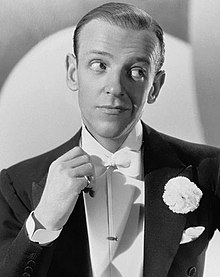TAP DAN C E
COMO O PAPO É
MÚSICA, ACHEI QUE ERA BOM RELEMBRAR ESTES GRANDES DANÇARINOS.
DIVIRTAM-SE:

Ginger Rogers (born Virginia Katherine
McMath; July 16, 1911 – April 25, 1995) was an American actress, dancer and
singer. She won an Academy Award for her starring role
in Kitty Foyle(1940), but is best remembered for
performing during the 1930s in RKO’s musical films with Fred Astaire. Her career continued on stage, radio
and television throughout much of the 20th century.
Born in Independence,
Missouri and raised
in Kansas City, Rogers and her family moved to Fort Worth, Texas, when she was nine years old. After winning a 1925
Charleston dance contest
that launched a successful vaudeville
career, she gained recognition as a Broadway
actress for her stage debut in Girl Crazy. This led to a contract with Paramount Pictures, which ended after five films. Rogers had her
first successful film role as a supporting actress in 42nd Street (1933). Rogers made nine films in
the 1930s with Astaire, which were some of her biggest successes such as Top Hat(1935) and Swing Time(1936). After two commercial failures with Astaire,
Rogers began to branch out into dramatic and comedy films. Her acting was well received by critics and
audiences as she became one of the biggest box-office draws and highest paid
actresses of the 1940s. Her performance in Kitty Foyle won her the
Oscar for Best Actress.
Rogers' popularity had peaked by the end of the
decade. She reunited with Astaire in 1949 in the commercially successful The Barkleys
of Broadway.
After an unsuccessful period in the 1950s, Rogers returned to Broadway in 1965,
playing the lead role in Hello, Dolly!. More lead roles on Broadway followed, along
with her stage directorial debut in 1985 on an off-Broadway production of Babes in Arms. Rogers also made television acting appearances until
1987. In 1992, Rogers was recognized at the Kennedy
Center Honors. She
died of a heart attack
in 1995, at the age of 83.
Rogers is associated with the phrase
"backwards and in high heels", which is attributed to Bob Thaves' Frank and
Ernest 1982
cartoon with the caption "Sure he [Astaire] was great, but don't forget
that Ginger Rogers did everything he did...backwards and in high heels".
This phrase is sometimes incorrectly attributed to Ann Richards, who used it in her keynote address to the 1988
Democratic National Convention.
A Republican and a devout Christian Scientist, Rogers married five times with all of them
ending in divorce, and having no children. During her long career, Rogers made
73 films, and her musical films with Astaire are credited with revolutionizing
the genre. Rogers was a major movie star
during the "Golden Age" of Hollywood and is often considered an
American icon. She ranks number 14 on the AFI's 100
Years...100 Stars list
of female stars of classic American cinema. Rogers' autobiography Ginger: My
Story was published in 1991.
TAP
DANCE
Fred Astaire (May 10, 1899 –
June 22, 1987) and Ginger Rogers(July 16, 1911 – April 25, 1995) were iconic
dance partners in a total of 10 films, nine of them with RKO Radio Pictures from 1933 to
1939, and one, The Barkleys of Broadway, with MGM in 1949, their only color
film.
Astaire and Rogers were
first paired together in the 1933 movie Flying Down to Rio. They were cast in supporting roles, with fifth
and fourth billing, respectively, but their performance in the
"Carioca" number was the highlight of the film, and RKO Radio Pictures was eager to capitalize on their
popularity.
In 1934, Astaire and Rogers made the musical
movie The Gay Divorcee, which co-starred Edward
Everett Horton. It
was their first joint starring roles in a movie and grossed even more than Flying
Down to Rio, with worldwide rentals of $1.8 million; the movie also
featured the classic Cole Porter
song "Night and Day". The song "The
Continental"
from the movie was a hit and was also the first song to win the Academy Award for Best
Original Song at the
1934 Academy Awards.
Astaire and Rogers made two movies in 1935. In Roberta, which featured the song "I Won't Dance", Astaire and Rogers received second and third
billing, respectively, behind Irene Dunne. It was a hit, with worldwide rentals of $2.3 million.
Top Hat, which also co-starred Horton, marked the first
time the duo had a film written solely for them, and it proved to be one of the
most successful films of the year, with worldwide rentals of $3.2 million. It
was the most profitable film RKO made in the 1930s, with profits of $1.3
million.
They were voted fourth on the Top Ten Money
Making Stars Poll for
1934-1935, as published by Quigley
Publishing Company.
By 1936, Astaire and Rogers were top box office
names. That year they made another two movies together: Follow the Fleet and Swing Time, which were both hits, earning worldwide rentals of
$2.7 million and $2.6 million, respectively. Follow the Fleet boasted
another Irving Berlin score, which featured the vignette "Let's Face
the Music and Dance".
Swing Time spawned the Oscar-winning song "The Way You
Look Tonight",
written by Jerome Kern with lyrics by Dorothy Fields, which Astaire sang to
Rogers. John Mueller
has cited Swing Time for possessing "the
greatest dancing in the history of the universe." The dance sequences for Swing
Time(e.g. "Never Gonna
Dance") are
considered by Arlene Croce to be the high point of their art. This
scene took 47 takes to perfect, during which the dancers had to ascend stairs,
spinning, until they perfected it. By the end of the shoot, Rogers' feet were
bleeding. They were voted the third biggest money making stars of 1936 in the
annual Quigley poll.
Astaire and Rogers made one movie in 1937, Shall We
Dance, once again
co-starring Edward Everett Horton. Although the film was RKO's biggest film of
the year, with worldwide rentals of $2.2 million, it did not perform as well as
the studio had expected. Shall We
Dance had the
first Hollywood score by the brothers George and Ira Gershwin, and included the song "They Can't
Take That Away from Me".
Although Astaire and Rogers would go on to make two more films together for
RKO, the film's relative disappointment at the box office was the beginning of
the end of their partnership.
After an unusually long period apart, Astaire
and Rogers made only one movie together in 1938, the 80-minute Carefree. During their time apart, Rogers appeared in the
successful movie Stage Door, while Astaire's career did not reach the same
heights he had achieved with Rogers. Carefree marked a departure for
their on-screen formula, featuring Astaire in a role unlike his usual typecast
persona, as well as less emphasis on the musical elements. Carefree was
originally supposed to include sequences shot in Technicolor, but RKO
considered the cost prohibitive, so it was filmed in black and white. This
movie feature an Irving Berlin musical score with only four songs, the fewest
in any Astaire and Rogers film. While the film was well-received by critics,
with Motion
Picture Herald's
William R. Weaver calling it "the greatest Astaire-Rogers picture",
it was their most expensive film to date, costing $1.3 million and ultimately
losing money for the studio, despite worldwide rentals of $1.7 million.
In 1939, Astaire and Rogers made The
Story of Vernon and Irene Castle. It was the end of their partnership for ten years.
Despite several successful films, RKO was facing bankruptcy. Due to the high
cost and low profit of the most recent Astaire-Rogers vehicles, along with the
stars' mutual desire to branch out, RKO announced the end of the on-screen
partnership. Although their relationship was amicable, both wanted to explore
new avenues. Rogers was interested in more dramatic roles than those she was
offered with Astaire. Meanwhile, Astaire, who worked with many dancers
throughout his career, no longer wanted to be paired with one permanent partner.
THREE LITTLE WORDS


GOSTARAM?








0 comentários:
Postar um comentário